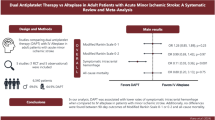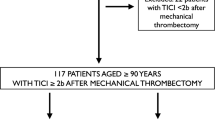Abstract
Background
The effectiveness of endovascular treatment for in-hospital stroke remains debatable. We aimed to compare the outcomes between patients with in-hospital stroke and community-onset stroke who received endovascular treatment.
Methods
This prospective registry-based cohort study included consecutive patients who underwent endovascular treatment from January 2013 to December 2022 and were registered in the Selection Criteria in Endovascular Thrombectomy and Thrombolytic Therapy study and Yonsei Stroke Cohort. Functional outcomes at day 90, radiological outcomes, and safety outcomes were compared between the in-hospital and community-onset groups using logistic regression and propensity score-matched analysis.
Results
Of 1,219 patients who underwent endovascular treatment, 117 (9.6%) had in-hospital stroke. Patients with in-hospital onset were more likely to have a pre-stroke disability and active cancer than those with community-onset. The interval from the last known well to puncture was shorter in the in-hospital group than in the community-onset group (155 vs. 355 min, p<0.001). No significant differences in successful recanalization or safety outcomes were observed between the groups; however, the in-hospital group exhibited worse functional outcomes and higher mortality at day 90 than the community-onset group (all p<0.05). After propensity score matching including baseline characteristics, functional outcomes after endovascular treatment did not differ between the groups (OR: 1.19, 95% CI 0.78–1.83, p=0.4). Safety outcomes did not significantly differ between the groups.
Conclusion
Endovascular treatment is a safe and effective treatment for eligible patients with in-hospital stroke. Our results will help physicians in making decisions when planning treatment and counseling caregivers or patients.



Similar content being viewed by others
Data availability
The supporting data are available from the corresponding author on reasonable request.
References
Cumbler E (2015) In-Hospital Ischemic Stroke. Neurohospitalist 5:173–181. https://doi.org/10.1177/1941874415588319
Saltman AP, Silver FL, Fang J et al (2015) Care and Outcomes of Patients With In-Hospital Stroke. JAMA Neurol 72:749–755
Goyal M, Menon BK, van Zwam WH et al (2016) Endovascular thrombectomy after large-vessel ischaemic stroke: a meta-analysis of individual patient data from five randomised trials. Lancet 387:1723–1731. https://doi.org/10.1016/s0140-6736(16)00163-x
Albers GW, Marks MP, Kemp S et al (2018) Thrombectomy for Stroke at 6 to 16 Hours with Selection by Perfusion Imaging. N Engl J Med 378:708–718. https://doi.org/10.1056/NEJMoa1713973
Nogueira RG, Jadhav AP, Haussen DC et al (2018) Thrombectomy 6 to 24 Hours after Stroke with a Mismatch between Deficit and Infarct. N Engl J Med 378:11–21. https://doi.org/10.1056/NEJMoa1706442
Akbik F, Xu H, Xian Y et al (2020) Trends in Reperfusion Therapy for In-Hospital Ischemic Stroke in the Endovascular Therapy Era. JAMA Neurol 77:1486–1495. https://doi.org/10.1001/jamaneurol.2020.3362
Lu MY, Chen CH, Yeh SJ et al (2019) Comparison between in-hospital stroke and community-onset stroke treated with endovascular thrombectomy. PLoS One 14:e0214883. https://doi.org/10.1371/journal.pone.0214883
Bulwa Z, Del Brutto VJ, Loggini A et al (2020) Mechanical Thrombectomy for Patients with In-Hospital Ischemic Stroke: A Case-Control Study. J Stroke Cerebrovasc Dis 29:104692. https://doi.org/10.1016/j.jstrokecerebrovasdis.2020.104692
Monch S, Lehm M, Maegerlein C et al (2018) Worse endovascular mechanical recanalization results for patients with in-hospital onset acute ischemic stroke. J Neurol 265:2525–2530. https://doi.org/10.1007/s00415-018-9035-0
Nam HS, Kim YD, Yoo J et al (2021) Comorbidity index for predicting mortality at 6 months after reperfusion therapy. Sci Rep 11:5963. https://doi.org/10.1038/s41598-021-85390-4
Lee BI, Nam HS, Heo JH et al (2001) Yonsei Stroke Registry. Analysis of 1,000 patients with acute cerebral infarctions. Cerebrovasc Dis 12:145–151. https://doi.org/10.1159/000047697
Park H, Kim YD, Nam HS et al (2022) Impact of Renal Function on Short-Term Outcome After Reperfusion Therapy in Patients With Ischemic Stroke. Stroke 53:3622–3632. https://doi.org/10.1161/STROKEAHA.122.039129
Hacke W, Kaste M, Fieschi C et al (1995) Intravenous thrombolysis with recombinant tissue plasminogen activator for acute hemispheric stroke. The European Cooperative Acute Stroke Study (ECASS). JAMA 274:1017–1025
Qiu K, Zu QQ, Zhao LB et al (2022) Outcomes between in-hospital stroke and community-onset stroke after thrombectomy: Propensity-score matching analysis. Interv Neuroradiol 28:296–301. https://doi.org/10.1177/15910199211030769
Almutairi S, Choudhury H, Najm M et al (2021) Workflow and Outcomes of Endovascular Thrombectomy for In-Hospital Stroke a Systematic Review and Meta-Analysis. J Stroke Cerebrovasc Dis 30:105937. https://doi.org/10.1016/j.jstrokecerebrovasdis.2021.105937
Kim M, Yang PS, Yu HT et al (2021) Changes in Cardiovascular Health Status and Risk of Sudden Cardiac Death in Older Adults. Yonsei Med J 62:298–305. https://doi.org/10.3349/ymj.2021.62.4.298
Lee MJ, Chung JW, Ahn MJ et al (2017) Hypercoagulability and Mortality of Patients with Stroke and Active Cancer: The OASIS-CANCER Study. J Stroke 19:77–87. https://doi.org/10.5853/jos.2016.00570
Navi BB, Kasner SE, Elkind MSV et al (2021) Cancer and Embolic Stroke of Undetermined Source. Stroke 52:1121–1130. https://doi.org/10.1161/strokeaha.120.032002
Dardiotis E, Aloizou AM, Markoula S et al (2019) Cancer-associated stroke: Pathophysiology, detection and management (Review). Int J Oncol 54:779–796. https://doi.org/10.3892/ijo.2019.4669
Han KT, Kim DW, Kim W (2022) Impact of Cardiovascular Diseases on Mortality in Gastric Cancer Patients with Preexisting Chronic Disease. Yonsei Med J 63:1043–1049. https://doi.org/10.3349/ymj.2022.0273
Yoo J, Nam HS, Kim YD et al (2019) Short-Term Outcome of Ischemic Stroke Patients With Systemic Malignancy. Stroke 50:507–511. https://doi.org/10.1161/STROKEAHA.118.023044
Sano T, Kobayashi K, Ichikawa T et al (2020) In-hospital Ischemic Stroke Treated by Mechanical Thrombectomy. J Neuroendovasc Ther 14:133–140. https://doi.org/10.5797/jnet.oa.2019-0048
Matsubara N, Hiramatsu R, Yagi R et al (2019) Characteristics and Treatment Results of In-hospital Acute Ischemic Stroke due to Large Vessel Occlusion Treated by Mechanical Thrombectomy. J Neuroendovasc Ther 13:281–287. https://doi.org/10.5797/jnet.oa.2018-0134
Heo JH, Kim YD, Nam HS et al (2010) A computerized in-hospital alert system for thrombolysis in acute stroke. Stroke 41:1978–1983. https://doi.org/10.1161/STROKEAHA.110.583591
de Campos Carvalho, Martins E, de Melo Luiz, Bernardi F, Maia Junior OT et al (2020) Similarities and Differences Between Primary Percutaneous Coronary Intervention and Mechanical Thrombectomy. JACC Cardiovasc Interv 13:1683–1696. https://doi.org/10.1016/j.jcin.2020.03.055
Aarnio K, Haapaniemi E, Melkas S et al (2014) Long-term mortality after first-ever and recurrent stroke in young adults. Stroke 45:2670–2676. https://doi.org/10.1161/strokeaha.114.005648
Meinel T, Lerch C, Fischer U et al (2022) Multivariable Prediction Model for Futile Recanalization Therapies in Patients With Acute Ischemic Stroke. Neurology 99:e1009-1018. https://doi.org/10.1212/WNL.0000000000200815
Funding
This study was supported by a faculty research grant from the Yonsei University College of Medicine (6-2022-0170) and grant from the Korea Health Technology R&D Project through the Korea Health Industry Development Institute (KHIDI), funded by the Ministry of Health & Welfare, Republic of Korea (RS-2023-00265497).
Author information
Authors and Affiliations
Consortia
Contributions
JWJ, KHK, JY, HSN, JHH, and YDK performed data analysis. JWJ, HSN, JHH, MB, JY, JK, HP, S-IS, J-HH, BMK, DJK, JNH, OYB, W-KS, J-WC, K-YL, YHJ, HSL, SHA, DHS, H-YC, H-JC, J-HB, GSK, K-DS, SHK, T-JS, SWH, JHP, JKC, and YDK obtained local data. JWJ, HSL, and YDK wrote the first draft of the manuscript or prepared the figures. All authors reviewed and edited the manuscript and approved the final version of the manuscript.
Corresponding author
Ethics declarations
Conflicts of interest
The authors declare that they have no conflict of interest.
Ethical approval
This study was approved by the Institutional Review Board of Severance Hospital, Yonsei University Health System (approval no.: 4-2023-0896).
Informed consent
Written informed consent was obtained from prospectively enrolled patients included in the SECRET or Yonsei Stroke Cohort studies or their families, and the institutional review boards of the participating hospitals approved both studies.
Additional information
Publisher's Note
Springer Nature remains neutral with regard to jurisdictional claims in published maps and institutional affiliations.
Supplementary Information
Below is the link to the electronic supplementary material.
Rights and permissions
Springer Nature or its licensor (e.g. a society or other partner) holds exclusive rights to this article under a publishing agreement with the author(s) or other rightsholder(s); author self-archiving of the accepted manuscript version of this article is solely governed by the terms of such publishing agreement and applicable law.
About this article
Cite this article
Jung, J.W., Kim, K.H., Yun, J. et al. Effectiveness of endovascular treatment for in-hospital stroke vs. community-onset stroke: a propensity score-matched analysis. J Neurol 271, 2684–2693 (2024). https://doi.org/10.1007/s00415-024-12232-4
Received:
Revised:
Accepted:
Published:
Issue Date:
DOI: https://doi.org/10.1007/s00415-024-12232-4




